
By Alastair Reid
Of all the major news events over 2015 it’s hard to think of one which didn’t feature footage captured by a member of the public. The age of eyewitness media, where anyone with a smartphone and social media account can take the place of professional camera person, has turned breaking news on its head and news organisations are still figuring out how to deal with this explosion in newsworthy material.
Issues of social newsgathering, verification, ethics and hoaxes are causing headaches in newsrooms around the world, so to see out the year we spoke to a range of experts about their opinion on the shifting landscape.
In the podcast below, Alastair Reid discusses the issues with:
Listen to the podcast or download it via Soundcloud, and check out what First Draft coalition members have to say about the year and what 2016 may bring.
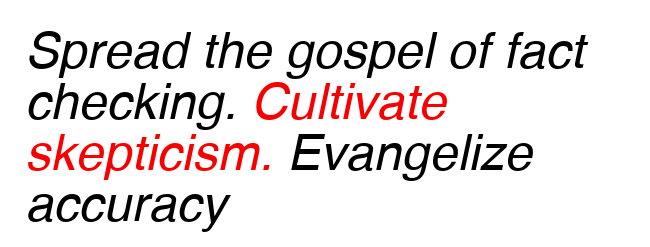
We need you. If you have ever helped a friend install Firefox, or set up a back-up system on your parents computer. We need you. If you’ve ever helped a colleague use spreadsheets, or taught a neighbor how to tweak Facebook’s privacy settings. We need you.
Verification and fact-checking are catching on, but not fast enough. Newsrooms should be teaching their communities. Journalism schools should be training their students. Journalists should be modeling best practices. In an age of participatory media it is up to all of us to help give the facts a fighting chance. Verification is increasingly a basic skill of digital literacy and a necessary aptitude of life online.
In 2016 we need you to learn how to verify photos, videos and eyewitness reports during breaking news. Then we need you to teach someone else. Spread the gospel of fact checking. Cultivate skepticism. Evangelize accuracy.
Now journalists and newsrooms are increasingly working together and sharing information during breaking news, to help improve coverage, serve communities, and get accurate information out to people who need it.
Yes, there is still a race to be first. Yes, there is still a lot of duplicated efforts. Yes, every eyewitness on Twitter still gets flooded by a deluge of journalists. But through projects like the First Draft News Coalition and the American Press Institutes Fact Checking work, people committed to accuracy and truth are working together to strengthen the entire field.
We need that collaborative work to move out from behind the scenes and into practice during breaking news. Working together across newsrooms, social media editors and real-time journalists can help slow the spread of misinformation, more quickly verify user generated content, and more efficiently and empathetically work with eyewitnesses on the ground.
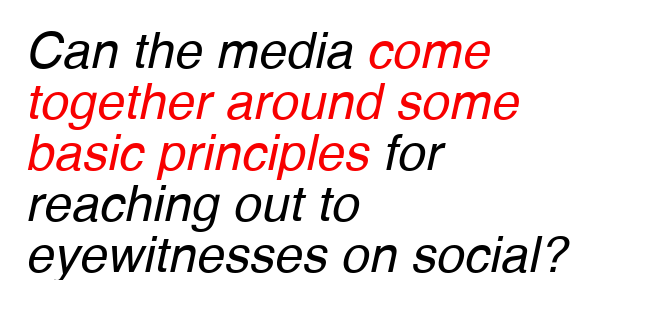
From the very start of 2015, eyewitness media was at the forefront of the world’s biggest breaking stories with the January 7 attack on Charlie Hebdo and the subsequent manhunt across France. As eyewitness accounts were at the center of this and many other stories this year, so came a renewed surge in outreach and usage requests from media outlets the world over, revealing in full a system that has been broken for quite some time.
On each major video from the day of the Charlie Hebdo attacks – and at the scene of every mass shooting and natural disaster since – are dozens, if not hundreds of requests from journalists, with sometimes two or three journalists from the same outlet trying again and again. For a person in the midst of the worst day of their lives, this onslaught of inquiries, often delivered without as much of a hint of sensitivity, can be devastating.
This issue of “outreach overload” has become a topic of conversation around every major news event among the journalism hoi polloi – but aside from naming and shaming social journalists who are just trying to do their jobs, the peanut gallery has had little to offer in terms of solutions.
Can the media come together around some basic principles for reaching out to eyewitnesses on social media? Can we find a way to tamp down the volume of requests and streamline our outreach across our organizations? Maybe in 2016, we can come together to make participatory journalism a bit less of a nightmare for eyewitnesses.
For years, those of us who work in social journalism have been able to find and communicate with eyewitness in the public spheres of networks like Twitter, Facebook, YouTube and Instagram. With a geographic or keyword search, we can be transported into someone’s viewfinder on the other side of the world and communicating with an eyewitness in a matter of moments.
Over the past year or so, the system has started to change right out from under us. New networks for person-to-person or closed-group communications like Snapchat, WeChat and WhatsApp have been exploding in popularity across the world, particularly in emerging social media markets in the Middle East, India and East Africa. Conversations that used to happen out in the open on public feeds have been taken behind closed virtual doors, where they are harder to find and even more difficult to authenticate.
When the eyewitnesses to major news events are sharing their experiences in a walled garden, we in the media have to take a new approach. In 2016, social journalism will have to shift from a search-based model of newsgathering to a community management approach. To get eyewitnesses and uploaders to share their experiences and content with us, we have to earn their trust. Whether we build them or join them, we in the media need to be a part of this next generation of contributor networks – and to do that, we need to change ourselves. We need to listen more and talk less. We need to respect privacy and anonymity. We need to be contributors and not just takers. There’s a new playing field in eyewitness media, and in 2016, we have to learn the game.

In 2015 I think it is fair to say that the value of user-generated content (UGC) within newsrooms was recognised at an industry-wide scale for the first time. Previously, social newsgathering from breaking news events with heavy UGC elements would be restricted to a few, larger news organisations.
In 2015 journalists of all types, working in both large and small news organisations in countries around the world, all decided to tackle social newsgathering with the urgency that it deserves. However, a negative theme relating to this revelation is the inevitable harassment that eyewitnesses have been subjected to when the world’s media descends upon them.
So for 2016: ethics, ethics and a few more ethics thrown in. Newsrooms will embrace a wider, more thoughtful and ethical approach to UGC. This won’t be because more training and resources will be available (though they will be), it will be because “the media” risk cutting off a steady flow of newsworthy UGC if they don’t change their ways. As more people turn to chat apps and private networks to share their content with their friends a communities, we risk being cut out if we don’t play nicely.

The year began with Facebook dealing a heavy blow to the purveyors of fake news. The social network announced on January 20 that it would allow users to flag content they see in their Newsfeed as “purposefully fake or deceitful news”, and also looked for behaviour patterns around hoaxes.
Many rightly wondered how many people would actually bother to flag fake news in their feed. But in the end the question appears to have been irrelevant. Traffic to fake news sites quickly dropped off as soon as 2015 arrived, according to at least one measurement company.
This was most likely thanks to its detection of people who were sharing and then deleting posts from certain sites. (I had an on-background conversation with people from Facebook months ago about this, and they were adamant that they’d not implemented a blacklist of sites in order to quickly reduce their prevalence in NewsFeed.)
The power of platforms like Facebook was debated, analyzed and, in some cases, lambasted. The fake news tweak to News Feed was a very small, mostly forgotten, initiative. It probably required relatively small amount of time and effort at Facebook, and yet to my eye it had a tremendous effect.
That’s the power of pushing product to 1.5 billion users.
The easiest prediction to make for 2016 would be to talk about the continued importance of platforms like Facebook in the spread and breaking of news. The year will undoubtedly be another where people in newsrooms, at conferences and elsewhere continue to grapple with what it means that more and more content being produced by large newsrooms is going directly to platforms, be it via Instant Articles or Snapchat Discover.
So what does this mean for the world of verification and debunking?
I think 2016 will be the year that misinformation gets autoplayed on a major scale thanks to Facebook native video.
The attention being paid by newsrooms to so-called distributed content will inevitably be mimicked by hoaxers and misinformation peddlers. We’ve long seen one-off images with fake information that spread like wildfire on Facebook. I think 2016 will see more of this, and we’ll see tricksters trying to emulate what credible news organizations are producing.
But more than anything, I think we’ll see far more hoaxes delivered via native video for Facebook. Perhaps they will look like NowThis or AJ+ in terms of aesthetics. Certainly the most effective will master the art of conveying compelling images and information in just a few seconds, no sound required.
If this prediction proves accurate, I hope it won’t take until 2017 for Facebook to figure out how to quash it like they did fake news websites.
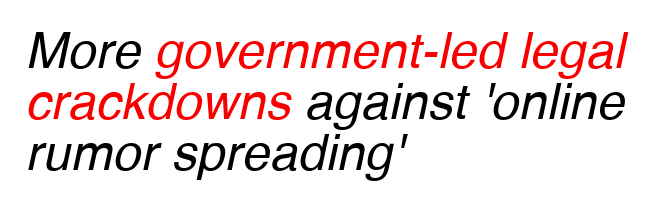
One trend I expect to continue and grow in 2016 is government intervention in verification and misinformation, in a range of ways.
We’ll see more state-sponsored misinformation that seeks to undermine the credibility of social networks as a news source, as we have already seen in 2015 from the Russian and Mexican governments. Recent stories like the San Bernardino shootings also point to more organized citizen-led disinformation, as groups seek to show up mainstream media’s verification failings.
Governments may also step up efforts to engage in fact-checking and verification to limit the spread of rumours (see Brazil’s new Fatos e Boatos initiative) and co-opting fact-checking and verification to push pro-government messages and harass reporters (see Egypt’s @FactCheckEgypt).
There could also be more government-led legal crackdowns against ‘online rumor spreading’ and ‘false information’ as witnessed earlier this year in China and Egypt. For those of us that see eyewitness media as a positive step-change for journalism, the need to remain vigilant is constant.
As journalists refine their verification skills and improve their ability to detect hoaxes and misinformation, authoritarian regimes and those seeking to appropriate social networks will increase the complexity and regularity of their attacks. Let’s rise to the challenge.

When Eyewitness Media Hub launched in November 2014, we presented a short video at the annual News Xchange conference called ‘The Etiquette of Consent”. The video featured one example of a Twitter user who had received over twenty requests in the first few hours of posting photos of a runway collision she had witnessed at Dublin airport.
The aim of the video was to kick start discussion within the industry of how to ethically, appropriately and effectively seek permission from eyewitnesses to use images they had posted online. Fast forward a year, and those numbers seem tiny compared to the hundreds of requests for images and information eyewitnesses now receive in the first few minutes of posting from the scene of a newsworthy event.
As we have continued to monitor these types of conversations over the past twelve months, we have seen significant improvements in some of the more concerning patterns that were beginning to emerge at the beginning of the year. Fewer journalists are duplicating requests already made by their colleagues; ownership rights are more frequently acknowledged; and language and tone is noticeably more appropriate when approaching eyewitnesses who may have experienced something traumatic.
But despite these positive developments, there is still some way to go in terms of addressing the criticism levelled at journalists by other social media users who observe and object to these first efforts to make contact. Anecdotally, I have seen a number of eyewitnesses suspend their social media accounts following overwhelming media attention, but I have also seen active journalists delete their personal profiles as a result of abuse they have received from an increasingly vocal community of detractors horrified by what they consider to be insensitive and intrusive behaviour.
To the public, this behaviour reflects on the industry as a whole rather than individual journalists or organisations. It could well be the case that the many newsrooms who take great care and pride in their social newsgathering practice are being undermined by the many more who don’t, and this is an area that warrants further research in 2016.
It has been a heartening year for collaboration in the news industry, and this looks set to continue in 2016. Social networks are collaborating with newsrooms to support discovery and distribution, individual technologists are collaborating with journalists to develop new tools for capturing, verifying and reporting stories, competing news organisations are collaborating on ways to improve standards and processes and, finally, community journalism and open source investigations are thriving.
Bringing the right people together to share knowledge, skills and ideas is central to the work of the First Draft Coalition and the interest and support that we have received since launch has already inspired plans for many collaborative projects in 2016.
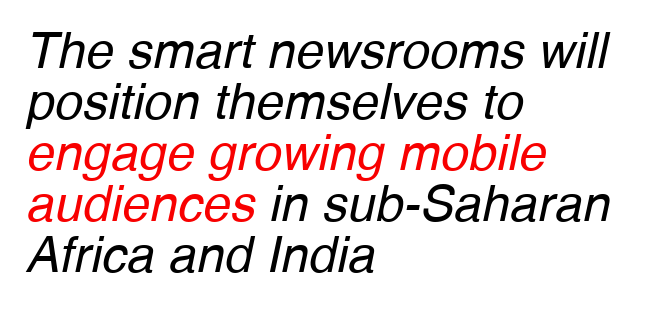
One of the welcome developments in 2015 is the advancement in tools that power social journalism. Professional tools like SAMDesk, Banjo, Crowdtangle and Dataminr have improved as first signals in discovery. Facebook Signal, the network’s native deep-search tool is a welcome addition. Although it is mainly US focused in its detection of trends, the search function is a valuable asset for geographies where other social platforms lag in user base and information. Signal also makes overdue amends for decommissioning two versions of Facebook search in recent years.
Technology cannot replace journalists in sorting fact from fiction, and journalists are fallible, as the regrettable Marie Christmas incident showed. However, a greater public awareness and emphasis on debunking and collaboration emerged in 2015 with the growth of social news services like reported.ly, Conflict News and Grasswire Facts.
Following from last year, 2016 will see an emphasis on video and social distribution, also described as off-platform distribution. News brands want to grow audiences, and social platforms are where the greatest digital growth is happening. AJ Plus, Now This News, Vocativ and Channel 4 are among the early adopters who understood and capitalized on this, particularly though their video offerings.
More content producers will seek to exploit opportunities with Chinese audiences in 2016. The smart newsrooms will position themselves to engage growing mobile audiences in sub-Saharan Africa and India.
Reported.ly’s first-year success was built on the social communities that helped us. By engaging with our audience and being responsive to their feedback, our journalism has improved and become more inclusive. Other newsrooms are engaging sources in new ways, through WhatsApp and other closed networks – although there are challenges in assessing the quality of information, networked access to more sources can only help journalism.
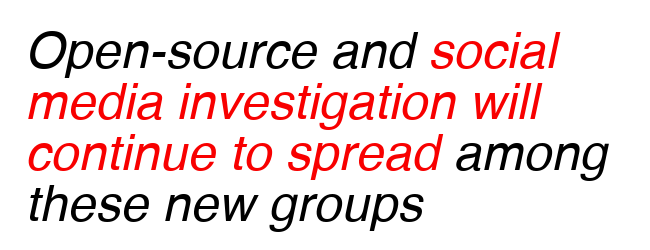
For me, the biggest change in the field of verification and open-source and social media investigation over 2015 was how awareness of the implications and usefulness of the work has spread. Now it’s not just journalists, activists, and human rights organisations which are using it in their work, but groups including law enforcement, policy makers, think-tanks, government, military, and even intelligence.
In 2015 Bellingcat continued its work on the downing of Flight MH17, and Bellingcat members were invited to speak at law enforcement and security conferences to discuss that work, receiving a very positive response. The Atlantic Council worked with Bellingcat on the release of their major report ‘Hiding in Plain Sight – Putin’s War in Ukraine’, which used open-source and social media investigation to expose the involvement of the Russian military in the conflict in Ukraine. This was well received at different levels of government across Europe and the US, and brought the methodologies used to a new audience.
In 2016 I believe the use of open-source and social media investigation will continue to spread among these new groups, and the core methodologies of verification will become an increasingly desirable skill in a wider range of organisations. We’ll also likely see the first results of the criminal investigation into the downing of Flight MH17, which may include open-source and social media information, and if it does it will be very interesting to see the reaction from various parties, in particular Russia.
Update: This article has been updated to correct Joe Galvin’s role from duty editor to news editor, Europe.